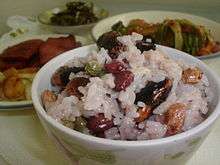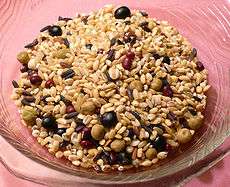Kongbap
| Kongbap | |
 A bowl of kongbap | |
| Korean name | |
|---|---|
| Hangul | 콩밥 |
| Hanja | n/a |
| Revised Romanization | kong bap |
| McCune–Reischauer | kong bap |
Kongbap is a Korean dish consisting of white or brown rice cooked together with one or more beans (and sometimes also other grains).[1] Kongbap may be made from scratch by combining and cooking together dried rice and beans, although it is also commercially available premixed packages in dried form in grocery stores throughout Korea, as well as in Korean grocery stores in other nations.photo Although the exact mixture may vary, typical ingredients include short-grain brown rice, green peas, azuki beans, black soybeans, Job's tears, black glutinous rice, barley, and sorghum. Another typical mixture consists only of white rice and green peas. The dried kongbap mixture is generally soaked in water for several hours or overnight before cooking, in order to ease the softening process of the beans while cooking.
Kongbap in culture
Although it is generally acknowledged as a healthful and nutritious food, kongbap was not universally enjoyed as it was associated with imprisonment. Kongbap had long been a staple of Korean prison food.[2] The Korean phrase kongbap meokda (콩밥 먹다; literally "to eat kongbap") translates colloquially as "to be imprisoned."[3] This is similar to a phrase in England with the same meaning: "to do porridge."
However, with a recent health food trend in South Korea, the popularity of beans has risen and kongbap is more commonly eaten in Korean households than before.[4][5]

See also
- Rice and beans
- Ričet, a European barley, bean, vegetable and pork stew also sometimes associated with prisons
- Nutraloaf, a meal common in the American Penal System.
References
- ↑ (Korean) Kongbap at Encyclopedia of Korean Culture
- ↑ (Korean) The reason why kongbap was replaced with boribap from JoongAng Ilbo
- ↑ (Korean) Definition and common phrases of kongbap from Nate Korean dictionary
- ↑ (Korean) Mixed grain rice, Medical Today, 2009-09-15. Retrieved 2010-06-27.
- ↑ (Korean) Black beans, Joongang Ilbo, 2010-06-04. Retrieved 2010-06-27.